
“He Don’t Know How to Stick His Hatchet in His Belt”
- David Sifuentes
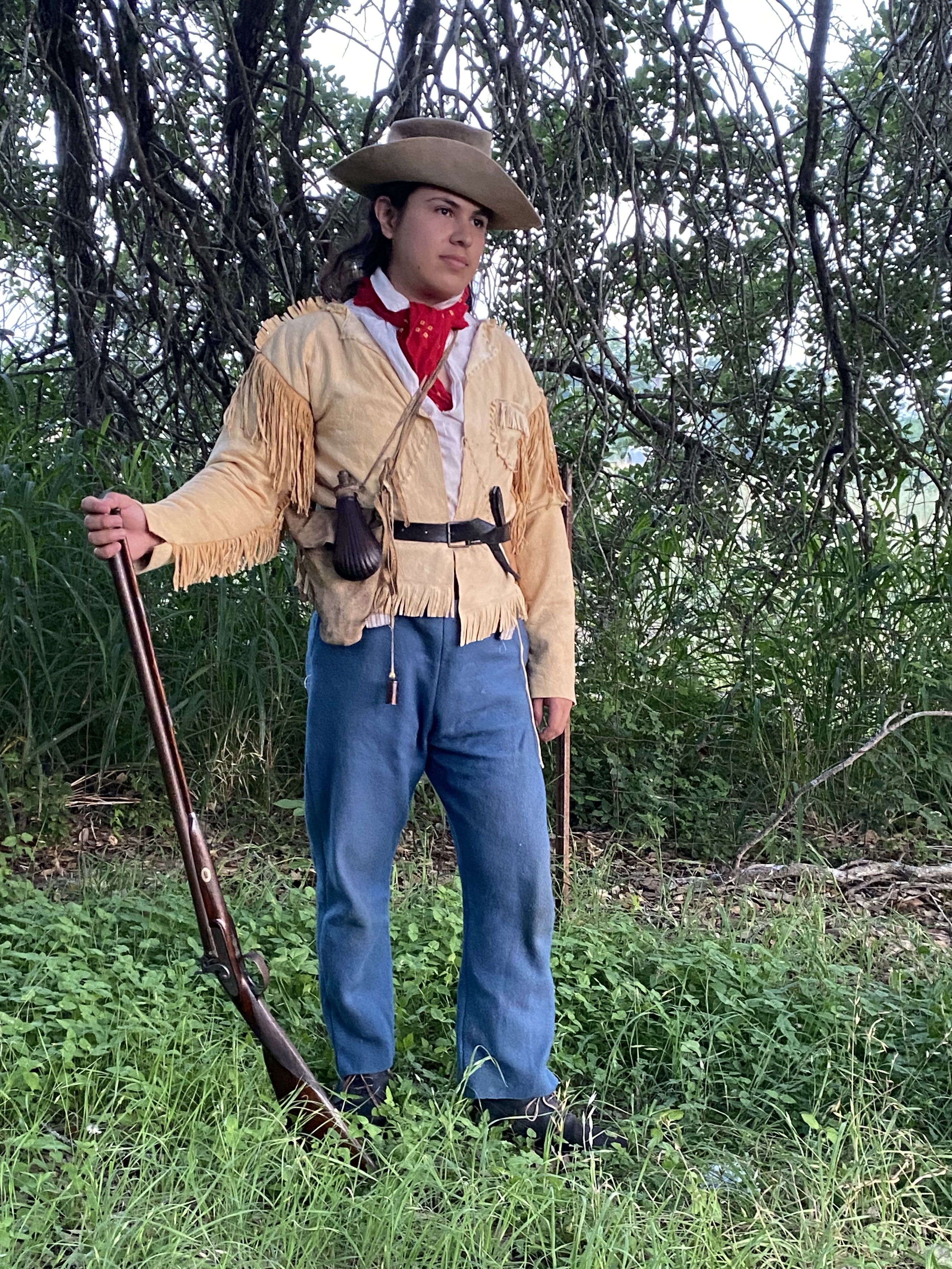
- Aug 9, 2025
- 6 min read
This go around at the dispatch we’ll be looking at a topic that’s been covered several other places so right off the bat I’m going to post those links here for quick reference. I also severely apologize for the hatchet job (only pun here I promise) of transposing any information over from those other sites. If it looks like a squirrel wrote this one while on crack- you’ve caught my ghost writer red handed.
The subject for this post is tomahawk/ax carriers and sheaths. Safety is a big part of our lives these days and walking around with an uncovered blade at your back or on your hip raises eyebrows for some people. Undoubtedly that was the most common means across the era of frontier America hands down for Anglos and Natives. If you’re Christopher Gist you solve the safety problem by having a dull ax but… that gave him his own problems. Let’s run down a chronological timeline for alternative methods of carrying an ax.
Content from Of Sorts for Provincials
An historical journal of the campaigns in North America for the years 1757, 1758 and 1760 Volumes I-III, Toronto Canada, Champlain Society, 1914-1916
p352 1759
"His knapsack is carried very high between his shoulders, and is fastened with a strap of web over his shoulder, as the Indians carry their pack. His cartouch-box hangs under his arm on the left side, slung with a leathern strap; and his horn under the other arm on the right, hanging by a narrower web than that used for his knapsack; his canteen down his back, under his knapsack, and covered with cloth; he has a rough case for his tomahock, with a button; and it hangs in a leather sling down his side, like a hanger, between his coat and waistcoat."
German Military ca 1783 from "Was ist oficier..." (for originals see Burg Forchtestine):

La Porterie ca 1754:
Arthur Wentworth of Bulmer, near Castle Howard, Yorkshire 1767
Pictures from Fur Trade Tomahawks
(Provenance for sling and carrier not given or known by author. David S.)

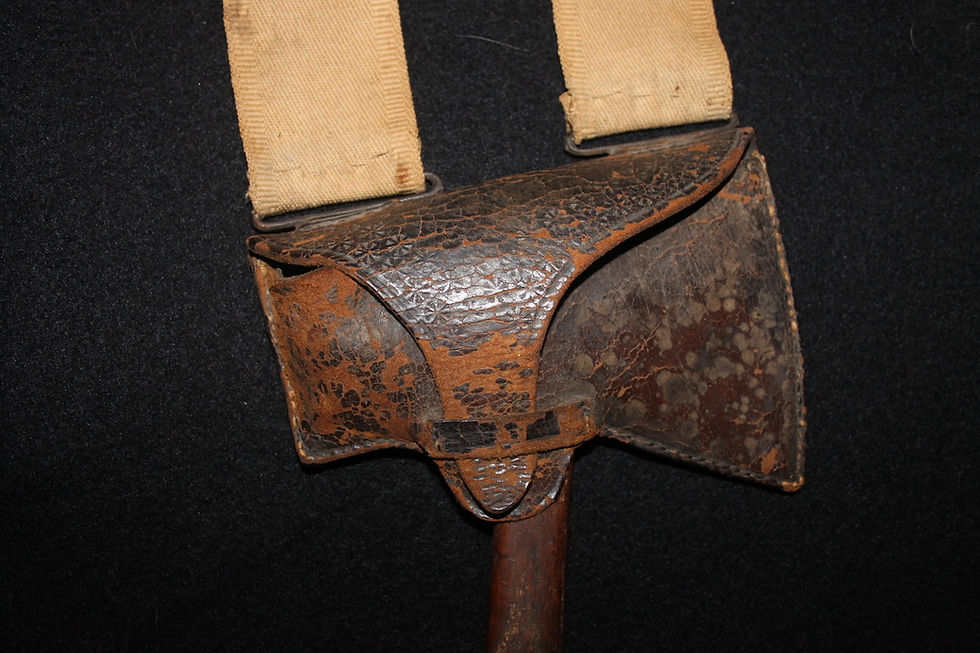
May 12, 1786 from William Price at West Point to Sec. of War Henry Knox.
Summary
Report on Quartermaster affairs and business at the West Point Army garrison; discusses repair of muskets; hiring of a carpenter; manufacture of nails; oiling of arms; reports forwarding inventories of ordnance and military stores; list of equipment forwarded.
"I have recevd yours of 6t Instant on 10th and have Now forwarded by Lt. Willcox the following articles to Capt Mercer
110 Knapsacks
110 Canteens & straps
1 Drum shell
2 Pewter Ink Stands
18 Narrow Axes
3 Orderly Books
3 Papers Ink Powder
6 Hatchets & slings
1 Pr Still Yards
6 Portmanteaus & Rods
& 40 axes for the Purpose of Common Stock in the Ohio"
Isaac Shelby tomahawk
Lets start branching out to some other cool originals and information not from those aforementioned articles.
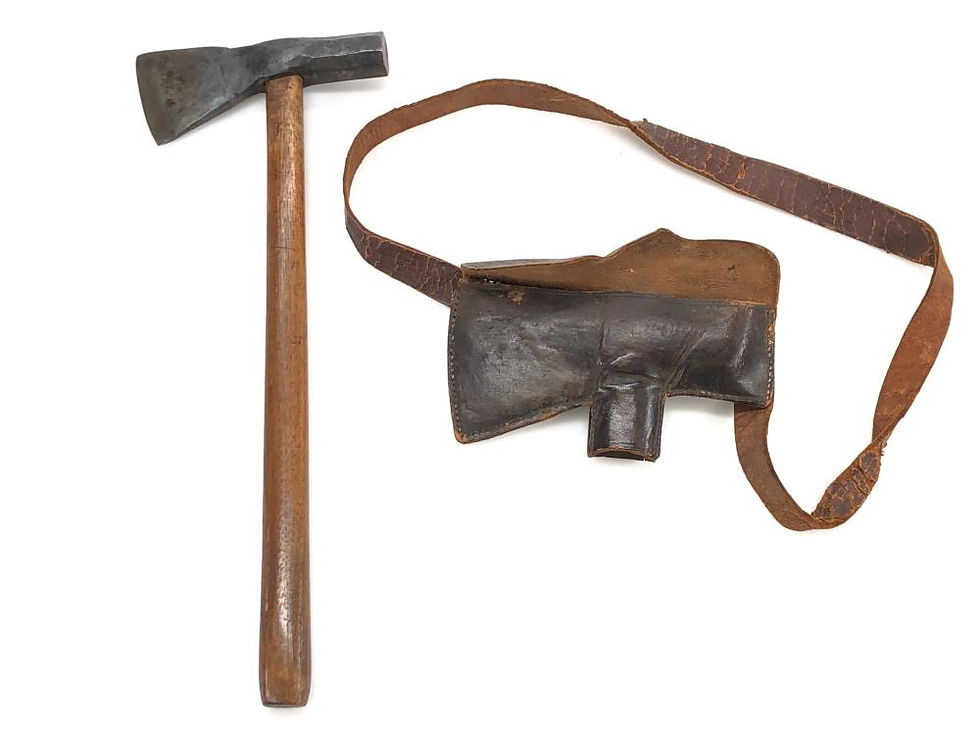

Speaking of Fort Pitt this is an alleged ax carrier from their collection as well.

The McKenzie carrier and tomahawk (late 18th century)

This image was pulled from Carl G. Russel’s phenomenal work Firearms, Traps, and Tools of the Mountain Men. The carrier and ax are also late 18th century.
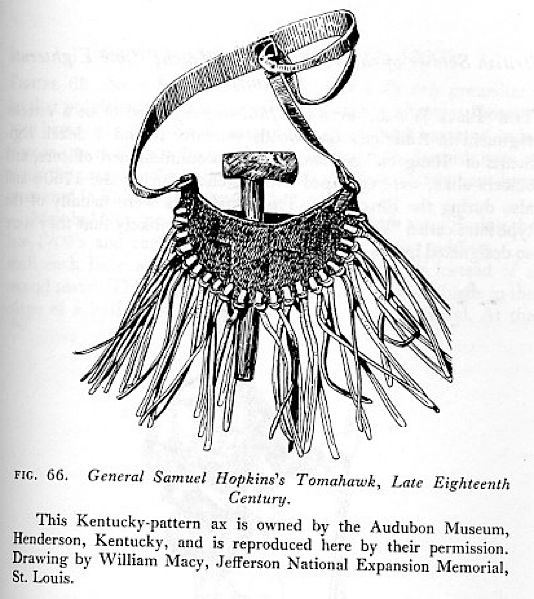
I’m not 100% confident on this image but it’s safe to say that if the artist was trying for an ax stuck in his belt he missed the mark.
John Lewis Krimmel "A Soldier Taking Leave from his Family" ca. 1812

Speaking of the war of 1812 here is a quote concerning the war that has a nugget of information for us. here is this snippet from Orlando Brown describing the sight of the Kentucky men going off during the war of 1812
"The Government did not equip the Kentucky volunteer in the rifle regiment. He furnished his own gunand his own clothes, and was paid eight dollars a month!The equipment of a volunteer in Hickman's company consisted of a hunting-shirt made of linsey, with a slight fringe border, color either blue, such as obtained from indigo, a pale yellow made from hickory bark, or a dingy brown obtained from the black walnut. His pants were Kentucky jeans, and he walked in shoes or moccasins, as was his fancy. Around his waist was a leather belt, on one side was a leather pocket fastened by leaden tacks, instead of thread, and in this was placed the indispensable tomahawk. Across his shoulder was the strap that held up his powder horn, in which strap was another leather case containing his formidable butcher knife, and another to hold his bullets. A knapsack of home manufacture contained his clothing, and the outside of it was garnished with a glittering tin cup. His well-tried-rifle, faithful and to be trusted in the hour of peril was his weapon of war."
Moving into the 1830’s Karl Bodmer has this image capturing what European tourists think were essentials on the American wilderness and this image doesn’t disappoint in that regards.
Karl Bodmer - The Travellers Meeting with Minatarre Indians near Fort Clark

It wasn’t just European men wanting leathers for their hatchets but women as well. Take Fanny Kemble for example

On my arrival at home — at the house — I can not call any place here my home! — I found Renty waiting to exhibit to me an extremely neatly-made leather pouch, which he has made by my order, of fitting size and dimensions to receive Jack's hatchet and saw. Jack and I have set up a sort of Sir Walter and Tom Purdie companionship of clearing and cutting paths through the woods nearest to the house; thinning the overhanging branches, clearing the small evergreen thickets which here and there close over and across the grassy track.
-Journal of a residence on a Georgian plantation in 1838-1839
But, the most ink and paint to get spilled in the 30’s about how one was to carry their hatchet is found in John Gadsby Chapman’s work of David Crockett.

The image is peak Davy trying to endear himself as a rural icon, and this belt carrier plays its part in the drama.
He was very precise in belt-arrangement of his "tools." The "butcher" in easy and prompt reach of his right hand—as well as powder horn and bullet-pouch. The Hatchet, as reserve, on the left hip, sufficiently accessible, just balancing weight, leaving nothing in the way, belt upwards-of free handling of his rifle-and limbs clear for any sort of work they might be wanted for...
I regret not to retain in memory the incidents of the interview between the veteran sportsmen, their animated and prolonged discussions over relative value of various "tools," and narrations of individual adventure and exploits, the cordial hand shaking at leave-taking, and the Colonel's warm invitation to "come out to Tennessee for a riproarious bar-hunt". He brought away, in gift of friendly remembrance, the powder horn and pouch that are in the picture and a bit of old leather, from which he cut and fashioned the hatchet sheath. "A grand old fellow!" he exclaimed as we strolled homeward. "A grand old fellow that!-When I'm President, I'll be shot if I dont put him into the War Department."
During its exhibition by the National Academy of Design in 1835 in New York, a prominent literary friends expressed desire to possess his autograph, and if attainable one of his letters, many of which I had from time to time received from him, but had bestowed upon eager seekers for them "Write to him," said my friend "and tell him that I say, he dont know how to stick his hatchet in his belt, and that the picture should be altered" His reply came by return mail— ***"Do'nt you go to altering my picture for any body's nonsense. If any man in New York says that I dont know how, or where, to stick my hatchet, send him to me and I'le show him"
So yeah… don’t go around telling the King of the Wild Frontier what to do!!!
As the decades progress belt carriers seem to be more of the norm than a slung variant.

This late 1840’s hunter is sporting some hairy swag, including a receptacle for his ax.


This rig from the 1850’s-60’s belonging to N. Nosworthy has so many good details but the hathet case stands out.

a loose, deerskin frock, open in front, and lapping once and a half round the body, was belted at the middle, forming convenient wallets on each side for chunks of hoecake, tow, jerked venison, screw drivers, and other fixings ; and Indian moccasins completed the hunter’s apparel. Over the whole was slung a bullet-pouch and powder-horn. From behind the left hip dangled a scalping-knife; from the right protruded the handle of a hatchet; both weapons stuck in leathern cases.
-The states and territories of the great West, Jacob Ferris 1856
We’ll end off with this off with bag set and ax, which honestly feels about as unhinged as this post has been; but hey, at least we can all leave here knowing where New Yorkers can stick their hatchets!




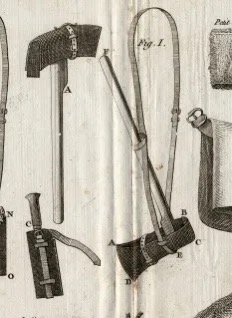









Comments